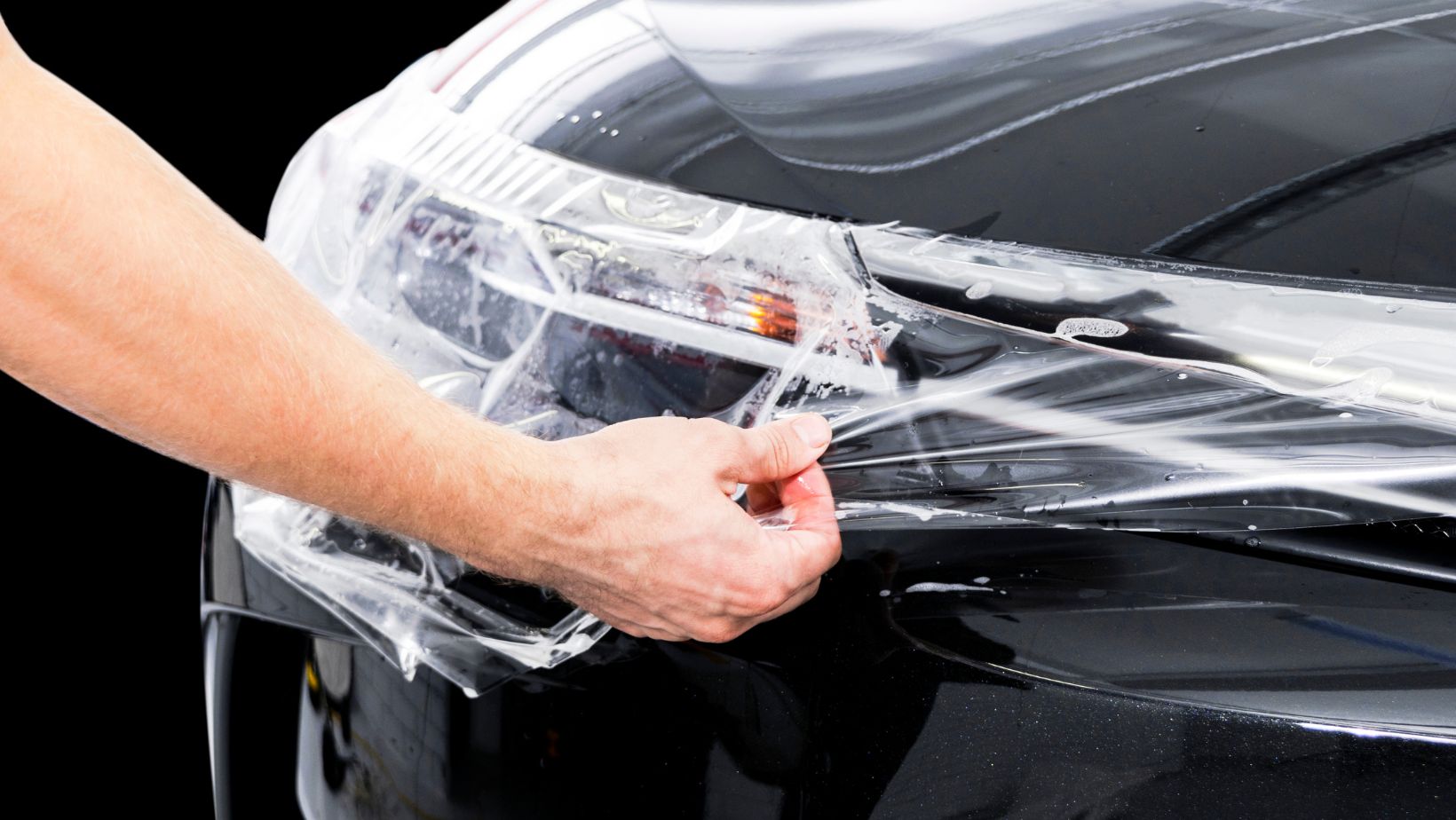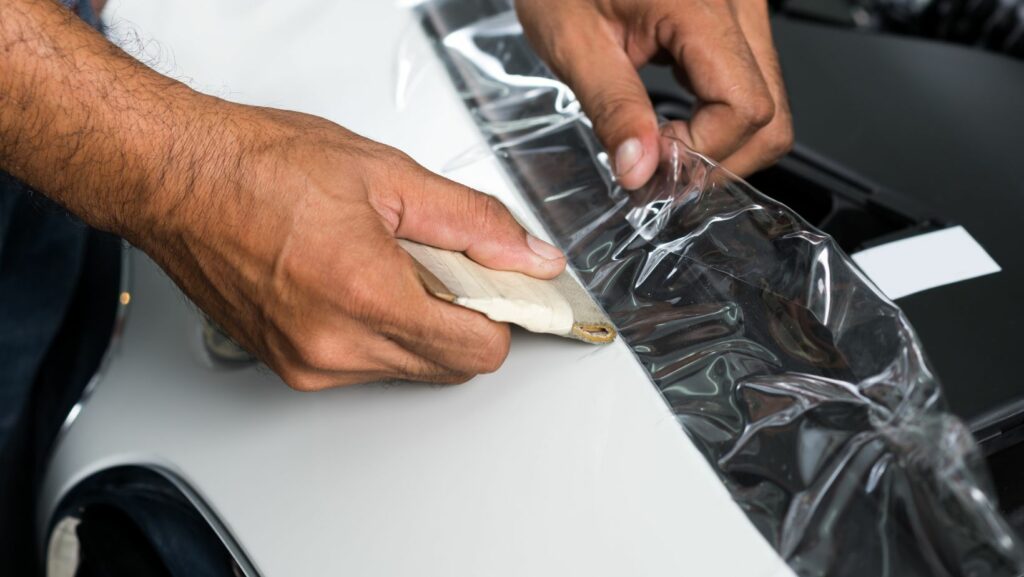Paint Protection Film (PPF) isn’t just a clear plastic wrap. It’s a carefully engineered multi-layered shield built to handle the real-world abuse your car faces every day. While it may look simple on the surface, every layer plays a distinct role in protecting against rock chips, UV rays, surface scratches, and road grime.
This article breaks down what’s inside PPF, how those layers work together, and what you should know before deciding if it’s right for your vehicle. We’ll also cover the installation process, key limitations, and considerations that matter over the long term.
Layers and Materials Used in PPF
Paint protection film is an engineering marvel that lies beneath its surface. It works just like a bulletproof vest, with multiple specialized layers that come together to give your vehicle’s paint the best protection possible.
Top Coat: Scratch Resistance
The film’s outermost layer stands guard as your first defence against everyday hazards. This clear coat blocks UV rays and won’t turn yellow. It’s about 0.5 mils (0.0132mm) thick.
The magic happens in this layer’s self-healing properties. Small scratches disappear with a bit of heat. Picture a piece of memory foam bouncing back to its original shape after you press it. This smart layer takes care of minor scratches, stains, and sun damage.
Premium films come packed with nano-ceramic particles that make water bead right off. These films are crystal clear. Your car keeps that perfect showroom shine without any orange peel texture.
Middle Layer: TPU for Flexibility
Thermoplastic polyurethane (TPU) makes up the heart of PPF. This crucial middle section takes up about 70% of the film’s build and comes in at 6.0 mils (0.152mm) thick.
TPU gives the film amazing stretch and strength to resist tears and punctures. Road debris hits the film instead of your car, so chips and scratches don’t stand a chance.
The TPU layer stays crystal clear and won’t yellow. Unlike cheaper PVC-based films, quality TPU keeps its strength and flexibility no matter the temperature. Your car’s complex curves get perfect coverage and lasting protection.
A leading manufacturer points out that TPU-based PPF lasts 5-10 years, but PVC films only make it 1-2 years. That’s a huge difference in how long your protection lasts!
Adhesive Layer: Bonding to Paint
The bottom layer uses a special high-molecular adhesive that sticks perfectly to your car’s paint. At 1.6 mils (0.040mm), this layer plays a key role in how well the film works.
This adhesive goes beyond regular sticker glue. It needs to:
- Hold tight even in extreme weather
- Stretch around your car’s curves
- Stay completely see-through
- Come off clean without paint damage

Top-quality adhesives peel off easily without leaving any mess or hurting your paint. The adhesive quality really shows the difference between cheap and premium PPF options.
How Paint Protection Film is Applied
The beauty of Paint Protection Film goes beyond the material – it’s the meticulous application process that makes it special. PPF installers work like skilled surgeons and follow precise steps to achieve perfect results. Let me show you how professionals turn a simple sheet of film into invisible armor that shields your vehicle.
Surface Preparation and Cleaning
The first step of professional PPF installation starts with proper surface preparation – maybe the most significant step. Your vehicle needs a complete wash to remove dirt, dust, and debris that might affect how well the film sticks.
The paint surface must be completely dry. Professionals use microfiber towels or air blowers to get rid of water from every spot, even those hard-to-reach areas. A single drop of water could ruin everything.
The sort of thing I love is the decontamination process that many people miss. A clay bar treatment gets rid of tiny contaminants like tar, tree sap, and industrial fallout that stick around after washing. These invisible bits could create bumps under the film if left behind.
Vehicles with visible scratches or swirl marks need paint correction before PPF application. This step uses polishing compounds and a dual-action polisher that smooths out the paint surface. Any imperfections would stay trapped under the film forever if not fixed.
The last prep step uses isopropyl alcohol or a special panel wipe solution. This removes any leftover residues from previous products and creates a clean surface that’s ready for film.
Cutting and Fitting the Film
PPF cutting comes in two main ways: plot-cutting and bulk installation. Plot-cutting uses a cutting machine to create precise cuts based on vehicle-specific templates. This method gives accurate fits but doesn’t wrap around edges as nicely as many people want.
Bulk installation puts larger sheets of PPF right on the vehicle before trimming. This needs more skill but looks better. One expert says, “A well-done bulk installation tends to have a better finish than a plot cut”. The installer wraps edges around each protected part to create a smooth look.
DIY enthusiasts can get pre-cut kits made for specific vehicles. These kits make cutting unnecessary, but need careful placement during installation.
The application uses a special “tack and slip” mixture of isopropyl alcohol, water, and baby shampoo. This solution helps float the film into place before it sticks permanently.
Heat Application and Curing Process
Installers use a squeegee to push out all liquid from under the film. This vital step removes air bubbles and helps the film stick properly. They work from the center outward with steady pressure to create a perfect finish.
Heat plays a key role after placement. Installers use a heat gun to warm the film, which activates its adhesive and helps it follow the vehicle’s curves. The heat also kicks in the film’s self-healing abilities.
The full cure takes 24 to 48 hours. Your vehicle should avoid water exposure during this time. The adhesive needs time to bond with the paint. Most experts suggest staying away from heavy rain, high-pressure washing, and direct sunlight for the first day.
A complete installation takes 10 to 20 hours, based on vehicle size and installer skill. Finding quality paint protection film near me through research will give a professional result.
Limitations and Considerations
Paint Protection Film has amazing capabilities, but it comes with its share of drawbacks. Let’s look at the other side of this protective technology to help you decide if PPF is right for your car.
Cost VS. Benefit Analysis
The biggest elephant in the room is definitely the price tag. A complete paint protection film installation costs between $1500 and $5500, based on your car’s size and film quality. Larger luxury vehicles might need up to $8000 for premium installations. This big upfront cost makes many car owners think twice.
The true value becomes clear when you look beyond the original costs. PPF lasts 5-10 years, which makes the yearly investment more reasonable. You can opt for partial coverage like front-end protection packages ($1100-$2000) if you want to protect just the key areas.
Your driving habits and vehicle type determine if it’s worth it:
- High-end vehicle owners who want to keep resale value
- Drivers who often use highways and face debris
- People who plan to keep their cars long-term
These groups usually find PPF worth the money. One installer puts it simply: “any film is definitely better than none” to protect your car’s looks and value.
Not a Substitute for Full-Body Paint Care
Premium film can’t shield against everything. PPF works great against rock chips and small scratches but won’t help much with deep gouges, heavy impacts, or vandalism.
On top of that, it doesn’t mean you can skip maintenance. You still need regular washing, but you must avoid harsh chemicals and rough tools that could damage the film.
Parts without film need traditional paint care. Many owners choose partial coverage to save money, which leaves some panels unprotected. This means you’ll need different care methods for different areas.
Potential for Yellowing or Peeling over Time
Film quality makes a big difference in how it looks years later. Cheaper films might turn yellow within 1–2 years, especially if your car sits in strong sunlight often.
Today’s premium films use UV inhibitors to fight yellowing, but all films wear down eventually. Pollution, big temperature changes, and chemicals can speed up aging.
The installation quality matters just as much for longevity. Bad surface prep leads to bubbles, peeling edges, and early failure. Finding installers with real experience becomes crucial for the best results.
Some people report that PPF adhesive might stick permanently to paint after 3-4 years in some cases. This can make removal tricky. Hood and fender areas that get really hot are especially likely to have this issue.
Conclusion
Paint Protection Film is more than a surface shield, it’s a multi-layered, science-backed solution built for real-world driving. Each layer has a job: resist scratches, absorb impacts, and hold firm under harsh conditions.
Understanding the materials and how they work helps drivers make informed decisions. Whether you’re protecting a high-end vehicle or preserving a daily driver, the right PPF can extend your car’s finish for years.
And while quality film matters, so does the installer’s experience and how you care for the film afterward. A thoughtful investment today can mean less worry, and more shine, down the road.

